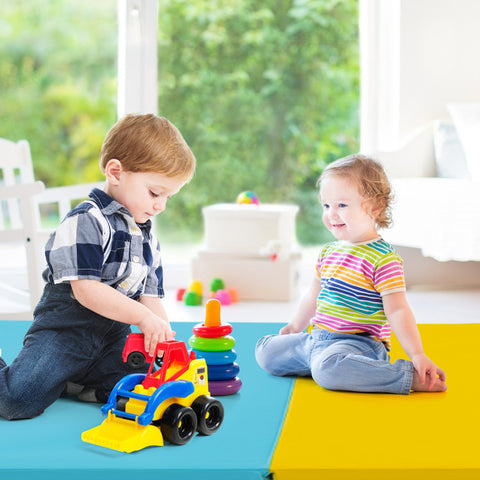News
Grip Matters: How Surface Texture Shapes Gymnastics Mat Performance
When most people think about gymnastics mats, they focus on thickness, foam density, or folding design. However, one subtle factor can make a major difference between a safe landing and a slip, the surface texture.
The texture of a gymnastics mat is far more than a design element. It defines traction, balance, sweat resistance, and overall athletic control. For both professional and beginner gymnasts, surface texture plays a vital role in maintaining precision and confidence during practice or competition.
Let’s explore how the texture of a mat’s surface influences performance and safety, and how manufacturers use science to design the perfect grip.
Why Surface Texture is Crucial
Gymnastics involves constant motion, running, tumbling, jumping, and landing. Each of these actions requires maximum grip between the athlete and the mat to prevent slipping or uneven balance.
A mat that’s too smooth can lead to slides during dismounts, while one that’s overly rough can cause friction burns or hinder fluid motion. The ideal surface texture strikes a balance, firm enough for traction yet smooth enough for comfort.
Types of Surface Textures in Gymnastics Mats
1. Smooth Vinyl Surface
- Common in competition mats and artistic gymnastics setups.
- Offers sleek aesthetics and easy cleaning.
- Suitable for routines involving balance or dance movements, where sliding transitions are part of the motion.
Drawback: Can become slippery with sweat or humidity.
2. Embossed Texture Surface
- Features small raised patterns (dots, ridges, or grids).
- Increases friction between the athlete’s skin or shoes and the mat.
- Ideal for tumbling and training sessions where traction is critical.
Example: “Diamond grip” or “cross-hatch” embossing improves hold without causing abrasions.
3. Micro-Patterned Foam Layer
- Used in premium mats with dual-layer designs.
- Microscopic texture variations maintain grip even under moisture or dust.
- Enhances stability during advanced aerial and landing routines.
Key advantage: Keeps consistent performance even in non-air-conditioned or humid environments.
4. Anti-Slip Coated Surface
- Coated with specialized polyurethane or PVC blends.
- Designed to maintain grip despite sweat or spills.
- Often used in portable folding mats or children’s gymnastics mats for added safety.
Note: Coating thickness and finish must be controlled precisely to prevent stickiness or uneven wear.
The Science Behind Grip and Friction
The physics of grip depends on surface roughness (Ra value) — the measure of texture height variations on the mat surface.
- High Ra values: More friction, better grip, but increased skin irritation risk.
- Low Ra values: Smoother feel, but potential for slippage under moisture.
Manufacturers test different Ra values between 0.4–1.0 mm to identify the ideal balance between safety and comfort for gymnastics applications.
Additionally, surface energy, the mat’s ability to interact with sweat or dust — affects grip. Advanced coatings use hydrophobic (water-repelling) finishes that prevent slipperiness caused by sweat buildup.
Environmental Impact on Surface Performance
Temperature and humidity can affect how the mat’s surface texture behaves:
- Hot conditions: Surface may soften, reducing grip.
- Cold conditions: Surface may harden, increasing friction and discomfort.
- Humid environments: Moisture can reduce surface traction unless treated with anti-slip coatings.
That’s why temperature- and moisture-resistant textures are increasingly used in modern mats to ensure consistent performance.
How Texture Enhances Athletic Confidence
For gymnasts, every detail of surface feel contributes to mental focus. When athletes trust the mat’s grip, they can commit to movements fully — without hesitation.
- Improved landings: Reduced risk of foot slippage.
- Better control: Stable footing improves balance and alignment.
- Confidence boost: Consistent traction promotes smoother transitions in routines.
This psychological aspect is as vital as the physical one — especially for competitive training.
Maintenance Tips to Preserve Surface Texture
- Clean regularly using mild soap and water — harsh chemicals erode surface coating.
- Avoid excessive scrubbing, which can flatten embossed or patterned textures.
- Dry completely before folding or rolling to prevent bacterial buildup.
- Rotate usage areas to prevent uneven surface wear.
- Avoid direct sunlight for extended periods — UV rays can harden the surface and reduce elasticity.
Proper care ensures the mat retains its texture and performance over years of use.
Innovations in Surface Texture Design
Modern technology allows manufacturers to create engineered textures that adapt dynamically to user pressure. Examples include:
- Pressure-sensitive grip zones that increase traction during landings.
- Multi-directional grain surfaces that maintain balance for lateral movements.
- Micro-fiber top layers that wick away moisture without sacrificing friction.
These designs combine biomechanics with material science — optimizing both safety and comfort.
Conclusion
While foam density and thickness often get the spotlight, the surface texture of a gymnastics mat quietly defines performance, safety, and athlete confidence.
The right texture ensures secure footing, prevents injuries, and enhances precision, especially during high-intensity routines. As technology advances, we can expect surface textures to become smarter, adaptive, and more athlete-specific.
In gymnastics, grip isn’t just physical, it’s the foundation of trust between the athlete and the mat.
FAQs
1. What is the best surface texture for gymnastics mats?
For training, embossed or cross-pattern textures offer excellent grip and control. For competitions, smoother finishes are often preferred for fluid motion.
2. Can textured mats cause skin irritation?
Only if the surface is overly rough. High-quality mats balance traction and comfort using fine-patterned embossing.
3. Do textured mats require special cleaning?
Yes, avoid harsh brushes or chemicals that may flatten or erode the pattern. Use soft cloths and mild cleaners.
4. How can I tell if my mat’s texture is wearing out?
Loss of grip, shiny spots, or smooth patches indicate surface wear and reduced traction.
5. Are textured mats more expensive?
Slightly, but the enhanced safety, durability, and grip quality justify the cost — especially for regular training environments.


